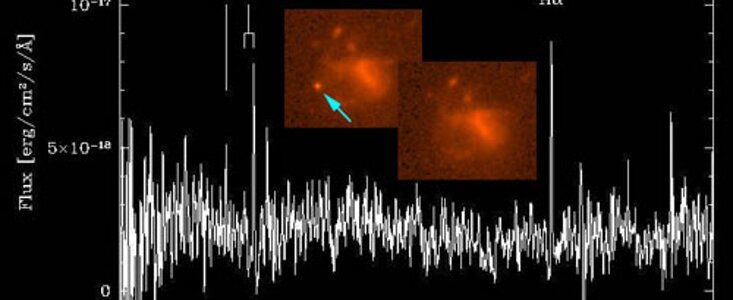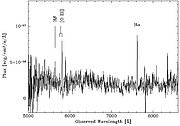Gemini Tracks Down Distance to Short Gamma-Ray Burst For The First Time
5 October 2005
Based on Press Release from the University of Hawaii, Institute for Astronomy
Astronomers using the Frederick C. Gillett Gemini Telescope on Mauna Kea have found the source of short flashes of gamma rays from outer space: a collision of two dead stars.
For 35 years, astronomers have been fascinated by mysterious flashes of high-energy radiation from apparently random places in the sky. These events, known as gamma-ray bursts, were first discovered by U.S. military satellites designed to monitor nuclear tests in space.
A typical burst lasts less than a few seconds, which makes them notoriously difficult to catch. In fact, until recently astronomers had been uncertain whether the bursts were coming from the solar system, the Milky Way, or distant galaxies. Because of this, research on the short bursts floundered for decades.
However on July 9, 2005, Paul Price of the University of Hawaii Institute for Astronomy and Kathy Roth of the Gemini Observatory received news of a burst detected by a NASA's High Energy Transient Explorer satellite. Tipped off by the X-ray glow from the fading remnant of the explosion, they measured the event to be 1.9 billion light-years away.
Price was ecstatic. "We've finally tracked down a short burst to a small galaxy a long way from our own."
The observations were made using the Gemini Multi-Object Spectrograph under less-than-ideal sky conditions. According to Roth, who coordinated the observations, “The sky was marginal at best, we were just barely able to squeeze in this observation between holes in the clouds and high humidity.”
In papers published in the October 6th issue of the science journal "Nature," Price and Roth, together with their collaborators at Penn State, Caltech and several other observatories, conclude that the July 9 event must have involved a "neutron star," a rare type of dead star so dense that each cubic inch weighs over a trillion tons. They believe that the outburst occurred when one neutron star collided with either another neutron star or with a black hole.
The two objects had probably been orbiting each other in ever decreasing circles for many millions of years before they finally touched. At that moment, the neutron star was ripped apart by the intense gravity, and everything funneled down a black hole within seconds, which powered the cosmic flash.
"The burst is so energetic, that I think it just has to involve a black hole," Roth explained.
If a gamma-ray burst were to occur near the solar system, it would have a major adverse effect on life on Earth. Astronomers already know of at least one similar pair of neutron stars in our own Milky Way galaxy, but these stars are not due to collide for 300 million years.



